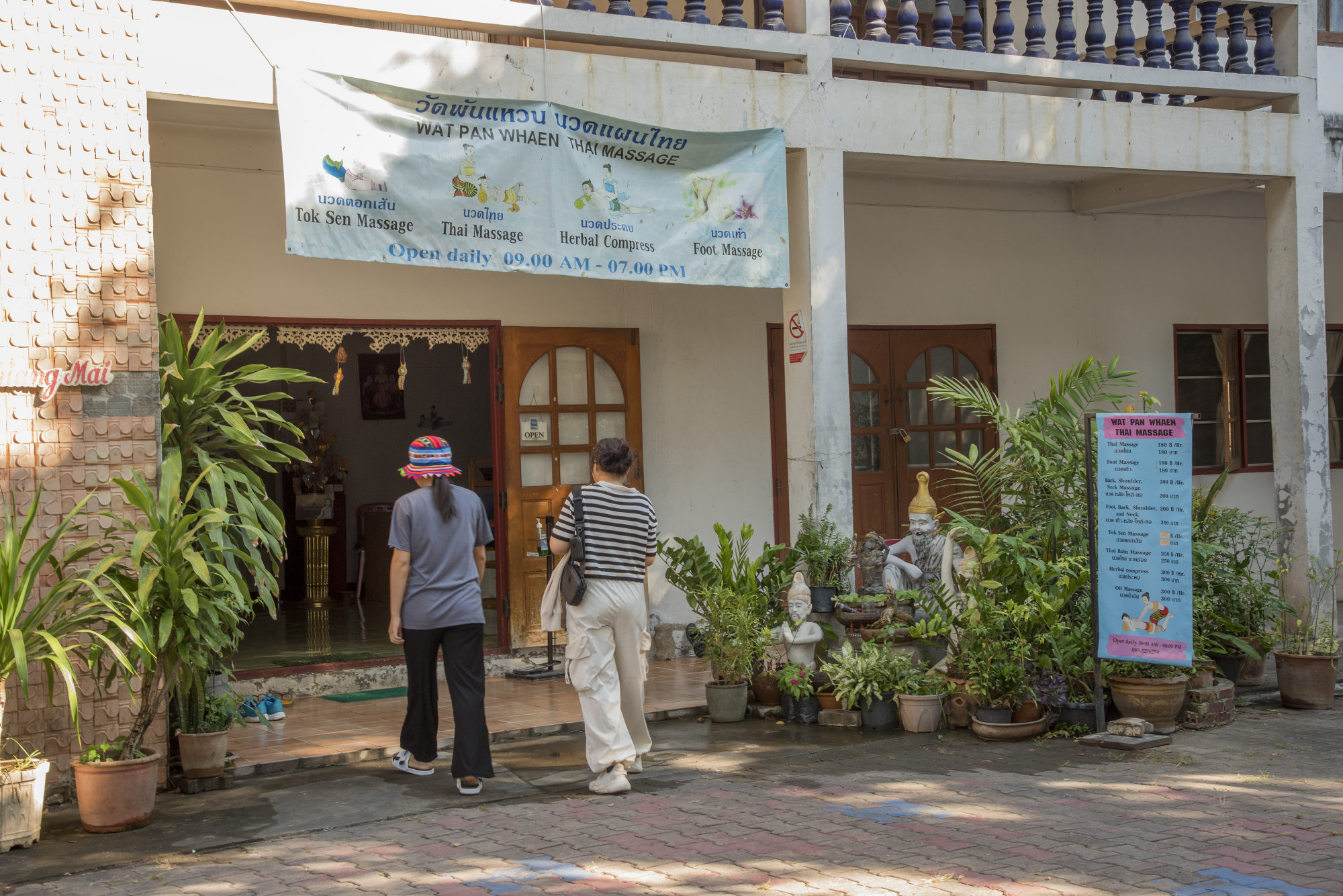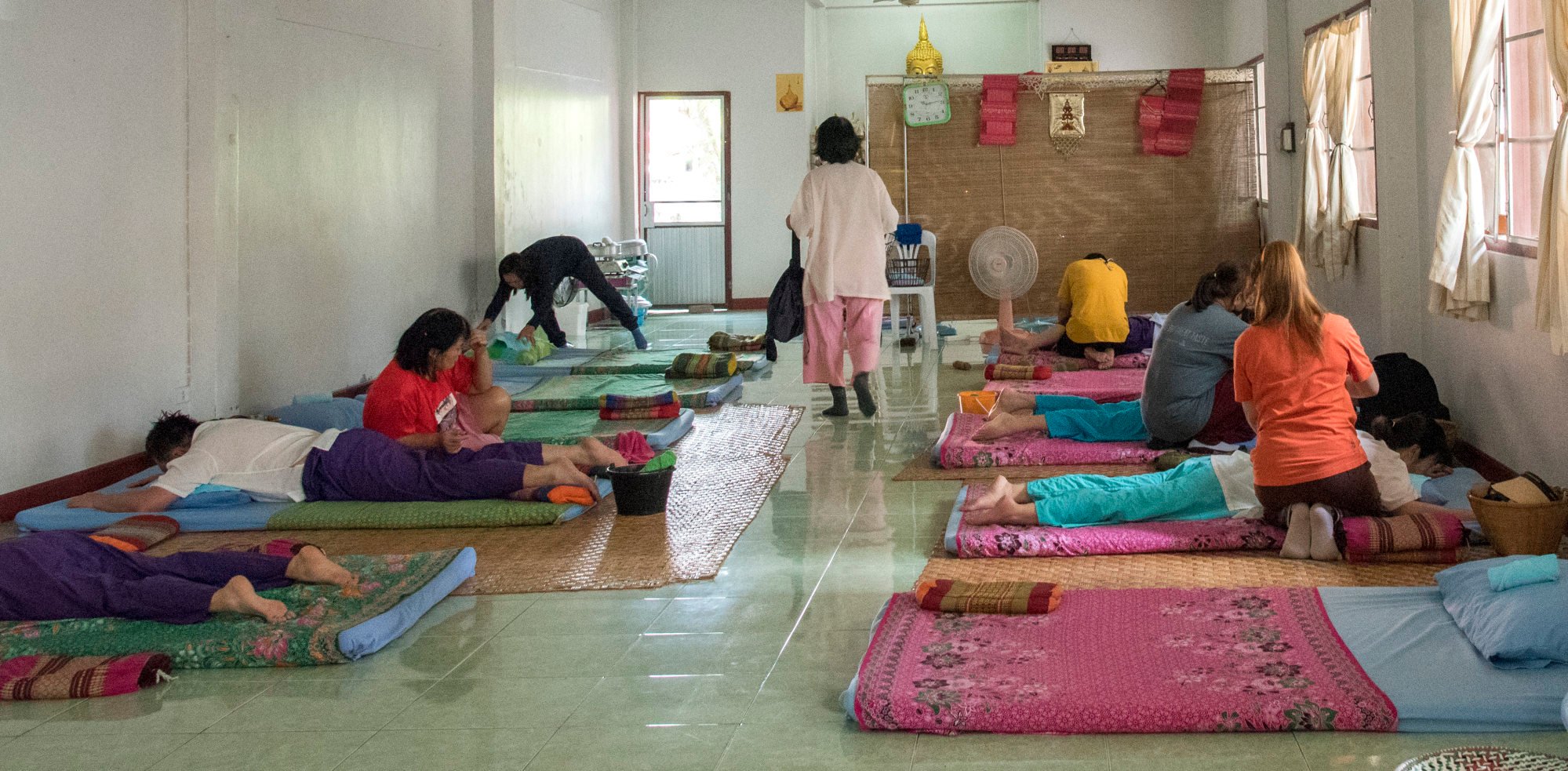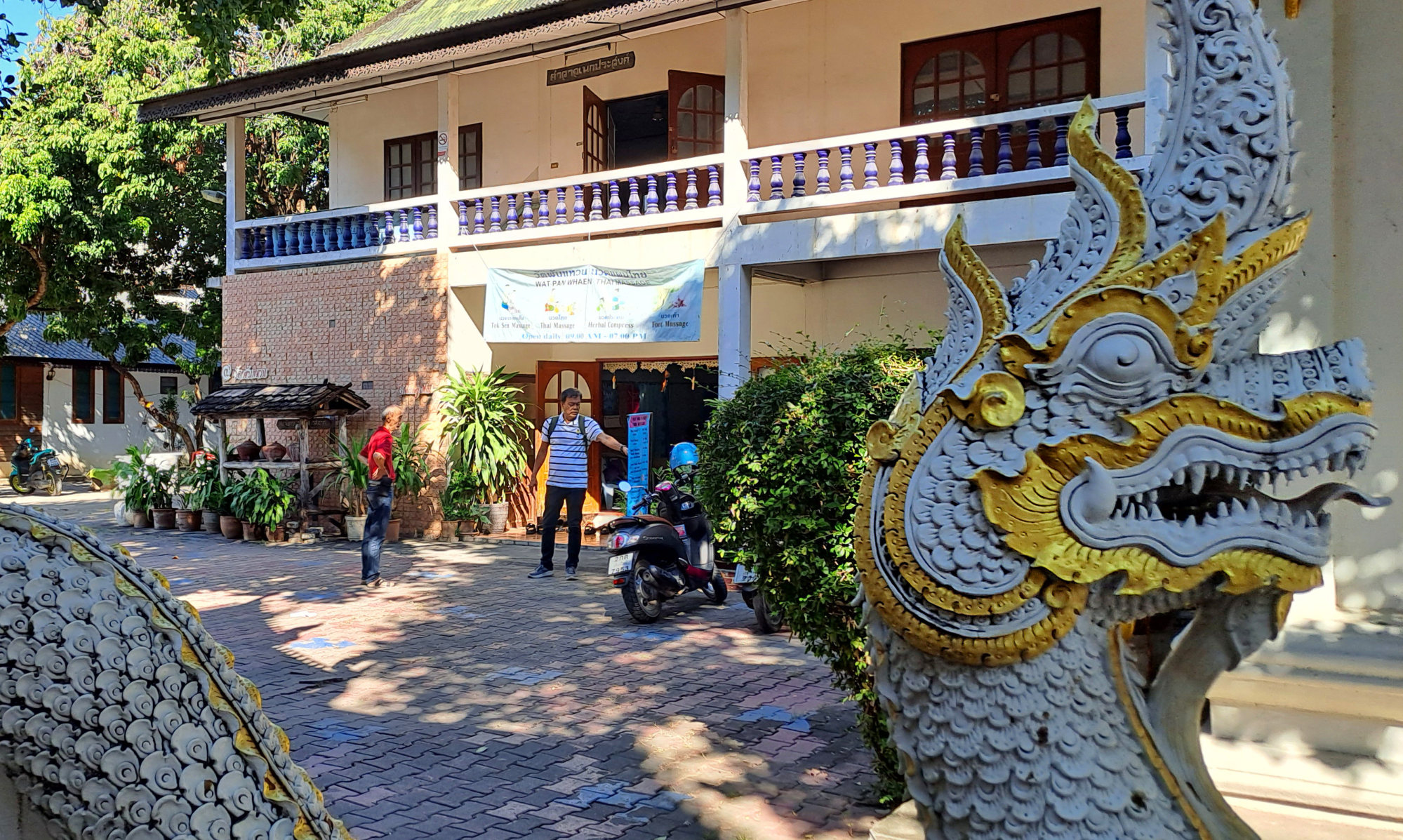
How cheap but excellent US$5 Thai massages at a no-frills temple in Chiang Mai attract locals and tourists alike
- Chiang Mai, in northern Thailand, is dotted with temples, and one of them, Wat Pan Whaen, is known for offering amazing, and very reasonable, massages
- Many of the highly skilled therapists have worked in the no-frills massage room for decades, and the US$5 massage has won many fans, both Thai and foreign
On a pleasantly cool January morning in Thailand’s northern capital, Chiang Mai, early risers jog beside the city moat, past fruit vendors selling fresh produce; plump red strawberries from the surrounding hills are a popular purchase at this time of year.
There’s a flurry of activity at the temples as well.
In the courtyard at Wat Pan Whaen, young monks sweep fallen leaves into neat piles and, after they’ve mopped the entrance steps, two women place offerings of incense sticks, bananas and lotus flowers next to a golden statue.
Each offers the Buddha a respectful wai, palms placed together, fingertips touching noses, and makes a silent wish for a rewarding day.

A few minutes later, the first customers pull up in a tuk tuk, as Thais call auto rickshaws. Wat Pan Whaen is one of Chiang Mai’s 300 temples, but it’s also a massage centre attracting Thais and tourists seeking relief from their aches and pains.
The temple is a no-frills kind of place, but definitely shouldn’t be confused with the less than wholesome massage parlours that many people associate with Thailand. There is one main room but no dividing curtains between the 14 beds. Waiting times are usually long because of a combination of low prices and highly skilled therapists, most of whom have pressed the flesh here for years.
Can Thailand turn Chinese fans of ‘T-wave’ stars into tourists?
Despite being a little rough around the edges – the toilets will never win an award for cleanliness – a soothing massage in a Thai temple is a bucket-list must for holidaymakers in search of authentic experiences, especially as there’s always the possibility that a saffron-robed monk might wander past.
Phoning friends back home is almost compulsory among tourists. “I’ve just had a massage in a Buddhist temple! Turn on video call so everyone in the office can see where I am!”
Recognised by Unesco as part of the Southeast Asian nation’s intangible cultural heritage, Thai massage evolved from Indian Ayurvedic and Chinese medicinal practices and is believed to date back 2,500 years.
In 2020, Thailand’s Ministry of Public Health estimated there were at least 10,000 massage outlets nationwide, but when the Covid-19 virus struck, they were among the first businesses ordered to close.
Four years on, many have reopened. Stroll the streets of Chiang Mai and you’ll be confronted by a plethora of multilingual signs offering aromatherapy oil rubs, herbal compresses and prenatal treatments, as well as neck, shoulder and Thai massages.
You can have your muscles manipulated by a blind practitioner or by an inmate from Chiang Mai Women’s Prison.

I first visited Wat Pan Whaen in early 2023, seeking enlightenment and a 90-minute neck rub. Countless customers have come and gone since then but as a regular, I’m now treated like one of the family.
This, in turn, has presented me with an opportunity to learn about the lives of the masseuses and monks who spend their time in a temple that doubles as a massage facility.
I’ve discovered that the day’s takings are split three ways. The abbot takes a cut for the temple, the managers pay themselves a wage, and staff are paid based on the number of hours they work and the type of remedies they provide.
Tok sen – rhythmic tapping along energy lines with a small wooden mallet – pays relatively well, for example.
Reviews for Wat Pan Whaen are many and varied, but as is usually the case with online ratings, they veer to the extreme.
Most are very positive: “This place is absolutely amazing” and “Best massage in Thailand”. Not everyone is impressed with their hour of pampering, though. “Very basic massage, nothing special”, and “Waste of time, waste of money” say two dissatisfied visitors.

The most common gripe concerns the absence of air conditioning. The room temperature is rarely an issue during Chiang Mai’s mild winter, but grumbles increase in the hotter, stickier months.
In response, staff suggest the customer might be happier visiting a luxury spa: “Many air conditioners. Thai massage only 1,000 baht [US$29]. Better for you I think.”
At Wat Pan Whaen, by comparison, a Thai massage costs a paltry 180 baht. Most customers decide the temple isn’t so hot and stuffy after all.
The low prices attract local Thais and bargain-hunting foreign tourists. A Canadian tells me his girlfriend spent the morning scouring the internet for the cheapest massage in Chiang Mai and stumbled on Wat Pan Whaen. She was happy with the massage but didn’t tip.
You might think it would be reasonable for people to hand over 200 baht and wave their hand in a “keep the change” gesture. In reality, plenty of punters wait for the 20 baht they’re owed.
Not every nation has a tradition of tipping extravagantly – Thailand is among them – but leaving a few baht is never a bad idea, particularly if you plan to return for another massage.

According to my sources, Australians and Koreans tend to be the best tippers, but the former, along with North Americans and Europeans, lose points with their hosts in other areas (be sure to douse yourself in deodorant before visiting).
Fussy clients, (“Press harder – no, that’s too hard – do it more softly. No, not like that”), often Asian, are a staff bugbear, and tourists who make appointments but don’t turn up are another source of irritation. No-shows can have a significant impact on daily earnings.
During a recent visit, I asked a masseuse for one piece of advice that would be handy for potential customers to be aware of.
“Visit in the morning,” she replied, quick as a flash.
It makes sense. Kneading bodies for up to eight hours non-stop (often there isn’t time for lunch) is as exhausting as it sounds. During the busiest part of the day, from about 3pm until the shop closes, at 6pm, energy levels plummet, backs begin to ache, thumbs become numb and staff are as likely as their customers to fall asleep.
Book a morning session and the team are fresh, alert and nimble-fingered. And queues are less likely.

It’s an unfortunate irony that because of the repetitive nature of the job, massage therapists often succumb to similar injuries – inflammation, swelling, strains and joint pain – to the people they’re healing.
Arrive at Wat Pan Whaen before opening time and you’ll see staff taking it in turns to massage each other into shape in readiness for another long day.
Many masseuses continue to work despite their chronic pain as they have bills, mortgages or their children’s college fees to pay. Some cut their losses and quit before their injuries become serious. There are a lot of former massage therapists in Thailand.
On the subject of serious injuries, more than a few members of the public have unrealistic expectations regarding the degree of healing a masseuse is qualified to provide.
They’re not permitted to diagnose medical conditions, although this doesn’t stop customers seeking advice about post-surgery complications or discussing torn ligaments, broken bones and other ailments that are beyond that which staff have trained for.
After all, if a massage therapist were able to replicate the diagnostic abilities, medical proficiency and expertise of a doctor, no one would ever pay more than 180 baht for a consultation. Plus a tip of course.

